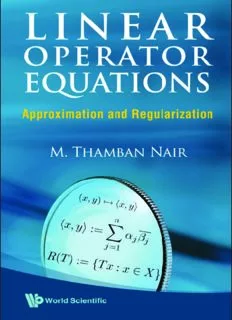Table Of ContentLINEAR
OPERATOR
EQUATIONS
Ap p roxi rn at io n and Reg u la rizat io n
TThhiiss ppaaggee iinntteennttiioonnaallllyy lleefftt bbllaannkk
LINEAR
OPEATOR
EQUATIONS
Approximation and regularization
M. THAMBAN NAIR
Indian Institute of Technology Madras
India
World Scientific
NEW JERSEY . LONDON . SINGAPORE . BEIJING . SHANGHAI . HONG KONG . TAIPEI . CHENNAI
TThhiiss ppaaggee iinntteennttiioonnaallllyy lleefftt bbllaannkk
Published by
World Scientific Publishing Co. Pte. Ltd.
5 Toh Tuck Link, Singapore 596224
USA office: 27 Warren Street, Suite 401-402, Hackensack, NJ 07601
UK office: 57 Shelton Street, Covent Garden, London WC2H 9HE
Library of Congress Cataloging-in-Publication Data
Nair, M. Thamban.
Linear operator equations : approximation and regularization / by M. Thamban Nair.
p. cm.
Includes bibliographical references and index.
ISBN-13: 978-981-283-564-2 (hard cover : alk. paper)
ISBN-10: 981-283-564-4 (hard cover : alk. paper)
1. Linear operators. 2. Operator equations. I. Title.
QA329.2.N35 2009
515'.7246--dc22
2009007531
British Library Cataloguing-in-Publication Data
A catalogue record for this book is available from the British Library.
Copyright © 2009 by World Scientific Publishing Co. Pte. Ltd.
All rights reserved. This book, or parts thereof, may not be reproduced in any form or by any means,
electronic or mechanical, including photocopying, recording or any information storage and retrieval
system now known or to be invented, without written permission from the Publisher.
For photocopying of material in this volume, please pay a copying fee through the Copyright
Clearance Center, Inc., 222 Rosewood Drive, Danvers, MA 01923, USA. In this case permission to
photocopy is not required from the publisher.
Printed in Singapore.
EH - Linear Operator Equations.pmd 1 3/20/2009, 6:32 PM
March20,2009 12:10 WorldScientificBook-9inx6in ws-linopbk
Dedicated to
My Mother
Meloth Parvathi Amma
v
March20,2009 12:10 WorldScientificBook-9inx6in ws-linopbk
TThhiiss ppaaggee iinntteennttiioonnaallllyy lleefftt bbllaannkk
March20,2009 12:10 WorldScientificBook-9inx6in ws-linopbk
Preface
Many problems in science and engineering have their mathematical formu-
lation as an operator equation
Tx=y,
whereT isalinearornonlinearoperatorbetweencertainfunctionspaces. In
practice,suchequationsaresolvedapproximatelyusingnumericalmethods,
as their exact solution may not be often possible or may not be worth
looking for due to physical constraints. In such situation, it is desirable
to know how the so-called approximate solution approximates the exact
solution, and what would be the error involved in such procedures.
This book is concerned with the investigation of the above theoretical
issuesrelatedtoapproximatelysolvinglinearoperatorequations. Themain
toolsusedforthispurposearethebasicresultsfromfunctionalanalysisand
some rudimentary ideas from numerical analysis. However, no in-depth
knowledge on these disciplines is assumed for reading this book.
Although there are many monographs and survey articles on particular
topicsunderdiscussion,thereexistshardlyanybookwhichcanbeusedfor
a mathematical curriculum to deal with operator theoretic aspects of both
well-posed and ill-posed equations. This book is an attempt to fill this gap
so as to be used for a second level course for an M.Sc. programme or for a
pre-Ph.D.programme. Suchacoursewillenablestudentstoknowhowthe
important theorems of functional analysis are in use for solving practical
problems that occur in other disciplines.
In the first chapter the concepts of well-posedness and ill-posedness
are formally introduced and a few examples of such problems are listed.
The second chapter equips the reader with the basics of functional ana-
lytic results which have been used throughout the text. The problem of
approximately solving well-posed equations, in particular, the second-kind
vii
March20,2009 12:10 WorldScientificBook-9inx6in ws-linopbk
viii Linear Operator Equations: Approximation and Regularization
equations, is treated in the third chapter. The fourth chapter is concerned
with the problems associated with ill-posed equations and their regulariza-
tion. In the fifth chapter, ill-posed equations with approximately specified
operators have been treated.
Although the book discusses some of the results published in a very
recent past, especially, on topics in ill-posed problems, this book is meant
only as an introductory text dealing with the issues concerning well-
posedness and ill-posedness of linear operator equations. Hence, the topics
covered and the discussions carried out in this text are far from exhaus-
tive. Readers interested in the topics under discussion are advised to look
into some of the excellent books on the subjects. For instance, the book
[5] by Atkinson is a very good reference for second kind operator equa-
tions, whereas the books by Baumeister [8], Louis [39], Engl, Hanke and
Neubauer [17] and Kirsch [34] give fairly good account on ill-posed opera-
tor equations. In fact, there are many journals exclusively devoted to the
subject on operator equations, for example, Integral Equations and Opera-
tor Theory, Journal Integral of Equations, Numerical Functional Analysis
andOptimization,InverseProblems,JournalofInverseandIll-PosedProb-
lems,etc.,andthereadersareencouragedtorefertothesejournalstohave
up-to-date status on the topics.
Examples,illustrations,remarksandexercisesareinterspersedthrough-
outthetext. They,alongwiththeproblemsattheendofeachchapter,are
intendedtohelpthereaderinunderstandingtheconceptsunderdiscussion.
Now, some words about numberings and certain notations. Lemmas,
propositions, theorems, corollaries, examples and remarks are numbered
consecutively within each category using two digits. To mark the end of a
proof of a Lemma, Proposition, Theorem, or Corollary, we use the symbol
(cid:3) while for marking the end of a Remark and Example, the symbol ♦ is
used. Bold faceisusedwhenanewterminologyisdefined, anditalicsare
used to emphasize a terminology or a statement.
Acknowledgments: This book had its origin in the form of Notes on
Linear Operator Equationspreparedformy personaluse duringmysecond
visittotheCentreforMathematicsanditsApplications(CMA),Australian
National University, Canberra, during June–December 1993. My interac-
tionandcollaborationwithProfessorsBobAnderssenandMarkusHegland
during that visit were of immense input for sustaining my interest in the
area of ill-posed problems. Subsequently, the notes grew in size along with
my own contributions to the field and my collaborations with my doctoral
Description:Many problems in science and engineering have their mathematical formulation as an operator equation Tx=y, where T is a linear or nonlinear operator between certain function spaces. In practice, such equations are solved approximately using numerical methods, as their exact solution may not often be

